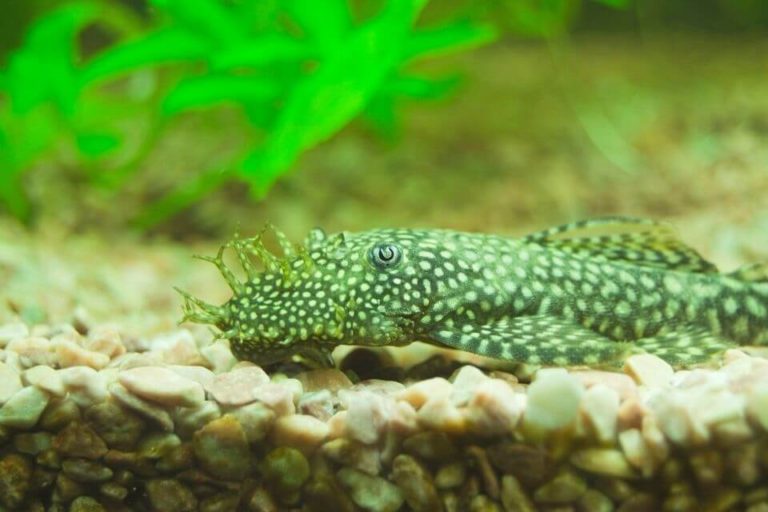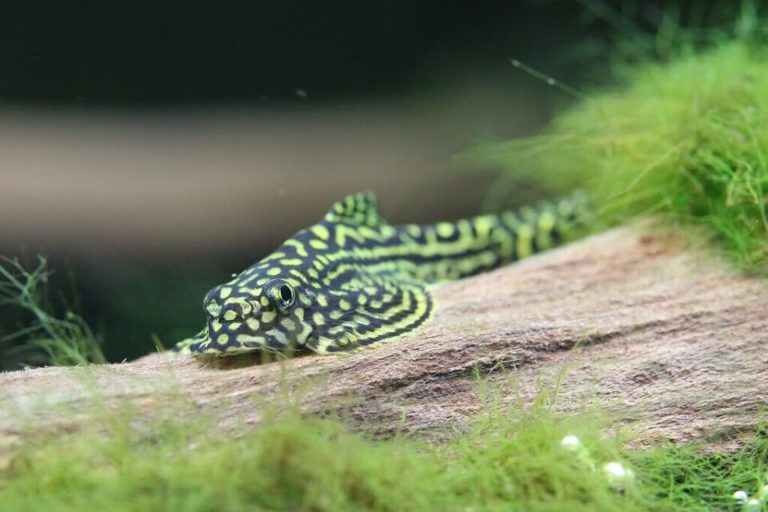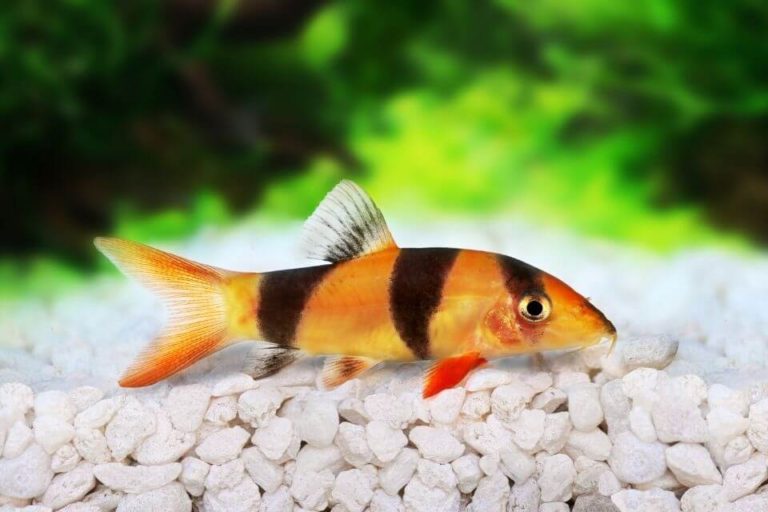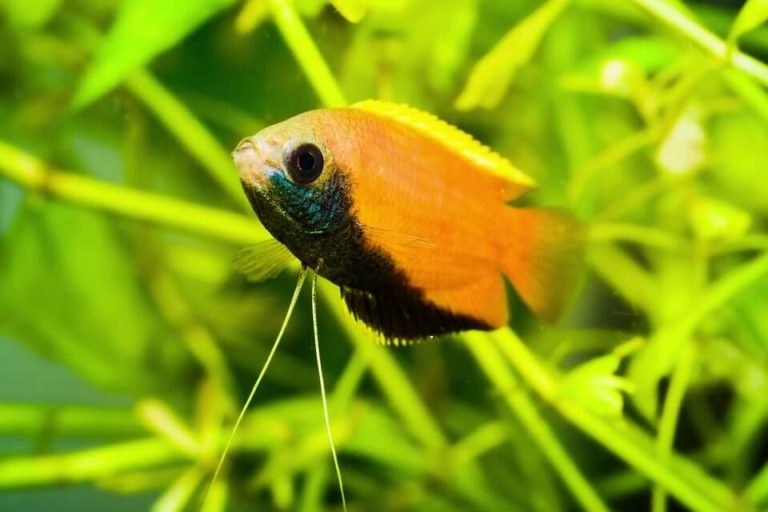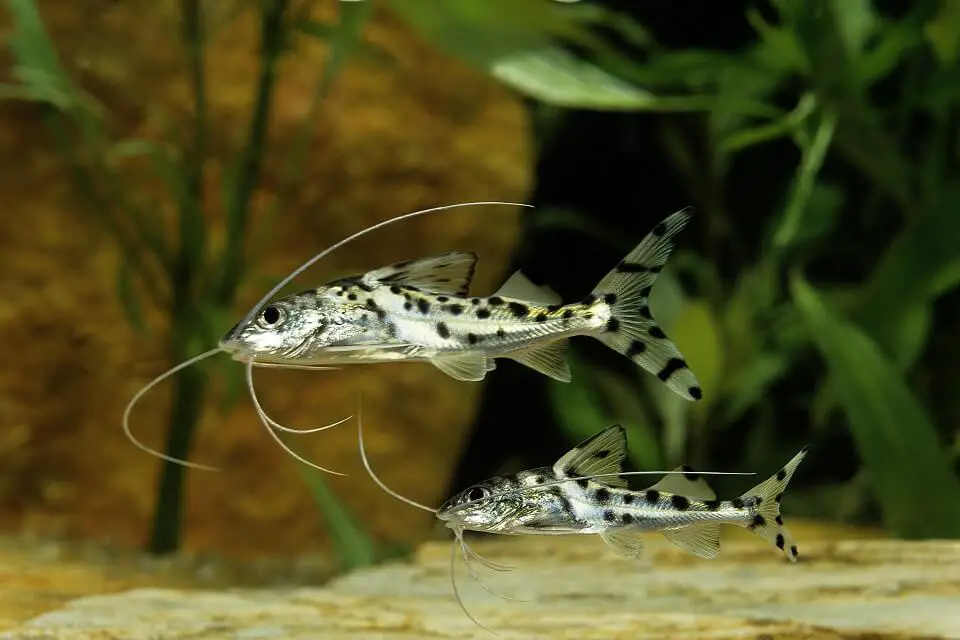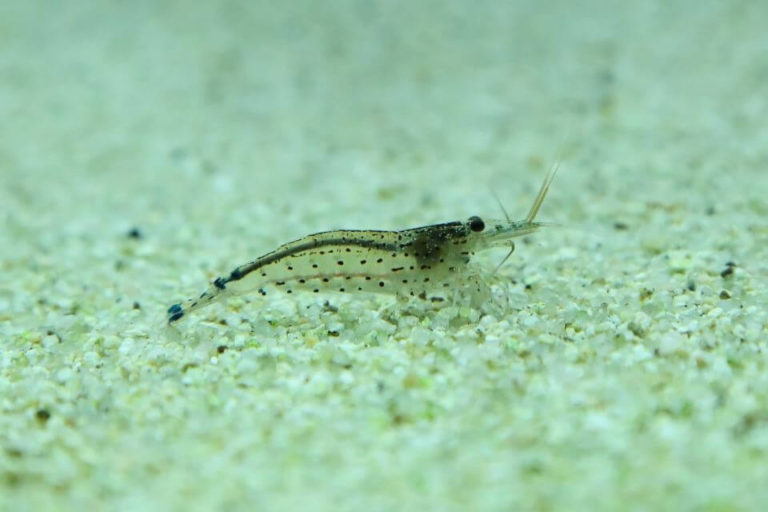Madagascar Rainbowfish Care 101 – Size, Lifespan, Tank Mates and More
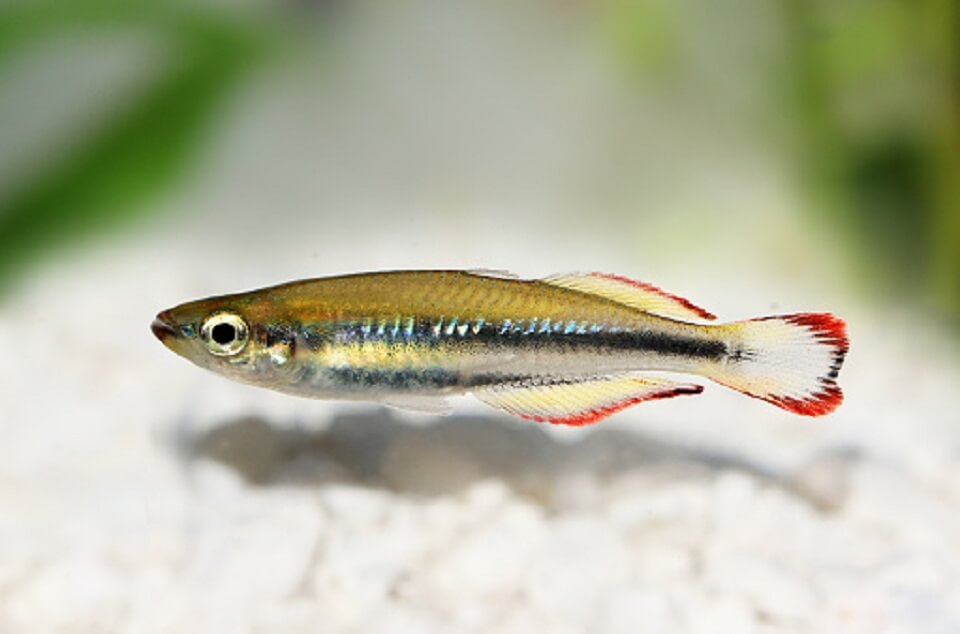
Madagascar Rainbowfish is a relatively hardy, undemanding species that can be kept in various aquarium conditions. These fish are commonly found inhabiting flowing waters such as rivers and streams in their native Madagascar.
However, they will do well under normal aquarium conditions as long as they are provided with slow water movement. The addition of rocks and driftwood to the aquarium will allow the fish to exhibit its natural behavior of darting in and out of the rocks.
These fish get their name from their bright coloration; they will display several brilliant colors that stand out against the dark background.
The male Madagascar Rainbowfish are typically more brightly colored than female fish, with reds and oranges contrasting sharply against their blackish backs. Female Madagascar Rainbowfish also have some orange coloring on body parts, but it is much less vivid than in males.
Species Overview
These Rainbowfish species have other alternative names and they are “Madagascan Rainbowfish” or “Malagasy Rainbowfish.”
This Rainbowfish species has gained popularity as an easy-to-keep, attractive aquarium fish. Since its introduction into the hobby, it has grown in popularity among aquarists and is one of the most well-known species of rainbowfish.
They are a riverine species found in the river basins of the Sambirano, Mangoro, and Onilahy Rivers in southern Madagascar.
There are at least three species in the genus Bedotia, but only the common Madagascar Rainbowfish is often seen in the aquarium trade that is traded as the name Bedotia Geayi. This rainbow fish inhabits Madagascar and that is why its’ name.
Malagasy Rainbowfish are also found in the island’s northern rivers, including the Mananara and Mangoro. It lives in areas with a moderate current and is often found near areas with rocks and overhangs.
Origin And Distribution
As mentioned above the Madagascar Rainbowfish is endemic to the island nation of Madagascar, off the coast of Africa. A freshwater species found in many rivers and streams on the island, they are suitable for an aquarium if peaceful and given enough space to swim.
Sadly, their natural habitats are under threat from deforestation and other human activities. Although these fish species are not known to be endangered yet but still suffer due to pollution and general habitat destruction.
When these Rainbowfish were introduced to the aquarium trade, they became famous because of their shape and vibrant color patterns. Most of the breeders have been bred commercially and distributed worldwide.
Appearance & Colors
Having the appearance of a slender, streamlined torpedo with large eyes and mouth, the Madagascar Rainbowfish has an overall silver to gray coloration with a dark-colored back giving the appearance of a dark gray silhouette.

As with most rainbowfish, the sides are marked with horizontal stripes in shades of yellow and orange with pinkish fins. The males are generally more colorful than the females, with bright red to an orange coloration on the dorsal fin and head.
Madagascar Rainbowfish Size
The Madagascar Rainbowfish is about 3 to 4 inches in length. The minimum tank size for this fish would be around 30 gallons, with 50 gallons being preferred.
These fish species require live foods, so a bigger aquarium is preferred to allow for the addition of feeder fish.
Madagascar Rainbowfish Lifespan
The Madagascar Rainbowfish lifespan is between 5 to 11 years with proper care.
Behavior & Temperament
The Madagascar Rainbowfish is generally peaceful and does well in community tanks with other small, non-aggressive fish.
They will be stressed when kept in a tank with active fish that nip at fins. Do not keep them with fish that are too small or slow-moving, as they will be unable to compete for food and become undernourished.
Mature males of this species can be territorial and aggressive towards one another, so it is best to keep only one specimen per aquarium. Always ensure you keep them with non-aggressive tankmates that are the same size and of the same temperament.
They are generally peaceful fish that will not bother any other tank mates, and they tend to prefer hiding in thick leafed vegetation. They will do just fine in a community tank with other peaceful species that are of similar size.
However, caution should be taken when placing them with larger and more active fish.
Madagascar Rainbowfish Care
The Madagascar Rainbowfish is generally a hardy species that can adapt to a variety of conditions. However, they do require a tank with plenty of plants and rocks for hiding places.
Provide a good current in the tank as it will make them feel more in wild. They should be fine if kept with other non-aggressive fish, but it is still a good idea to monitor them for illness or distress.
While this species is generally easy to care for, some important notes must be kept in mind when setting up a tank for them. These fish require good water conditions and plenty of hiding spaces in live plants.
Some driftwood or bogwood that is submerged can be added to simulate the natural habitat of this species.
The Madagascar Rainbowfish swim in the middle and top portions of the aquarium. It will occasionally swim closer to the bottom, but not for long periods. When active, they should be able to stay in the upper half of the water column.
– Madagascar Rainbowfish Tank Size
As mentioned previously, the Madagascar Rainbowfish prefers flowing water, and the addition of rocks or driftwood will create that type of environment. The tank size should be at least 30 gallons for this fish but we recommend 50 gallons.
The Madagascar Rainbowfish requires a larger aquarium, so it is not suited for most nano tanks. Do not overcrowd the tank with too many fish; keep in mind that this species can grow big.
– Madagascar Rainbowfish Tank Setup
The Madagascar Rainbowfish are medium size fish, so they require big tanks. Breeding them in a small tank is an epic failure. Setting up a tank for your Rainbowfish is just as important as setting up any other tank.
The substrate, plants, rocks/driftwood, and filtration method all make a difference in the health of your Madagascar Rainbowfish.
Substrate: They should be kept in a tank with at least 2 inches of substrate. A sandy substrate with some gravel is the best option for this species because it will not cloud the water.
Decorations: There will need to be a good mix of plants and open space in the tank. It is important to ensure that the Madagascar Rainbowfish has plenty of hiding spaces, as this will give the fish a more natural feel.
Driftwood and rocks should be added to the tank as they provide hiding places and create a natural aesthetic.
Filter: A sponge filter will be best for your Rainbowfish, as it provides an ample amount of filtration without creating too much current. Using a power filter is an option, but the flow should be calm.
Lighting: The light should be relatively dim for the Madagascar Rainbowfish, as they are mostly active during dusk and dawn. If you are keeping it with live plants, the lighting should be as bright as possible.
– Water Conditions And Parameters
The water conditions and tank parameters are very important for your Madagascar Rainbowfish. It ensures that the fish are living in the best environment possible that will enhance their growth.
You must keep in mind the following conditions when setting up a tank for them.
- Water Acidity Range: 4.5 – 7.5 pH
- Temperature: 73 – 89 °F (23 – 32 °C)
- Hardness: 0 – 15 dGH
- Water Movement: Moderate
- Type: Freshwater
– Common Diseases And Prevention
Madagascar Rainbowfish are generally very hardy fish, but they may become sick if the tank conditions are not up to par. Below you will find information on some of the most common diseases that may affect your fish.
White Spot Disease ( ICH)
A disease that causes little white spots all over the body of your Madagascar Rainbowfish. It is easily cured if treated quickly but can become fatal if left untreated. You can prevent this by making sure that the tank is clean and that there are no stressors present.
Skin Flukes:
The symptoms of this problem are clamped fins and little black dots on the skin. You can’t see these with the naked eye, so you will likely need a magnifying glass. This is also very easy to treat and prevent by making sure that your tank is clean and there are no stressors.
Hole in the head disease:
This condition is caused by poor diet, stress, or high organic matter in the tank. This fish will have a hole between its head and dorsal fin.
The good news is that this disease is pretty rare, but it can be very deadly if it is left untreated. The best way to prevent this disease is by keeping the tank clean and providing a good, varied diet.
Parasitic infestations:
There are very few types of parasites that affect the Madagascar Rainbowfish, but one is known as Hexamita. The symptoms of this parasite are weight loss and a lack of energy.
If this parasite is present in your aquarium, then it is likely that you have poor tank conditions. The best way to prevent this parasite is by making sure that your tank conditions are good.
Bacterial infections:
Bacterial infections in this fish species are rare, but they can become infected if the tank conditions are not up to par. Symptoms of a bacterial infection include cloudy eyes, clamped fins, or a lack of energy.
If your Madagascar Rainbowfish becomes infected with this bacteria, then it is best to treat the tank with salt. If you are noticing any of the symptoms mentioned above, then it is best to treat your Madagascar Rainbowfish with an antibiotic.
Madagascar Rainbowfish Diet And Feeding
In the wild, Madagascar Rainbowfish eat insects, insect larvae, crustaceans, and plant matter. In the home aquarium, they will usually eat most types of algae, as well as flake food and sinking pellets. They should be fed once or twice a day.
You must make sure that your Rainbowfish are eating a proper diet to keep them healthy.
Gender Differences
The differences between male and female Madagascar Rainbowfish are very subtle, but they exist. Males can be distinguished from females by the brighter coloration and more pronounced fins while the female is duller.
Males also have longer spins than females, but this is very hard to verify.
Breeding Madagascar Rainbowfish
The Madagascar Rainbowfish is a livebearer, but it has been very difficult to breed in captivity. In nature, they will spawn after heavy rainfall or when the water level of a stream rises.
They are generally kept by hobbyists with experience, as beginners may find breeding them to be more of a challenge than they would be expected.
The female Madagascar Rainbowfish will grow larger than the male. In some cases, she will become so large that she even has trouble fitting into the tank.
During mating, males will extend their fins in courtship, and they will typically do a “dance” where they swim towards the female with their fins extended. To initiate spawning, the male and female will swim together.
The female will release her eggs, which are then fertilized by the male, then placed on plants or rocks. Females can release about 1 to 2 eggs at a time. After the spawning has occurred, it is best to separate the fish, or else they will eat the eggs.
Madagascar Rainbowfish Tank Mates
The Madagascar Rainbowfish is compatible with most fish species of the same size. However, there are some species of fish that may not coexist well with the Madagascar Rainbowfish in an aquarium environment because their water conditions may match too closely.
These species include the following barbs, tetras, danios, characins rasboras, other Rainbows, dwarf cichlids, and similar fish.
How Many Madagascar Rainbow Fish Should I Get?
The Madagascar Rainbowfish is generally easy to care for. However, they are quite shy and must be kept in schools of 6 or more individuals, so they may be challenging to get.
Are Madagascar Rainbow Fish Aggressive?
Madagascar Rainbowfish are great for any beginner or experienced aquarist, and they can live in a wide range of water conditions and are not aggressive towards other fish.
If you have the space, then they are perfect candidates to be kept as pets! Remember to do your research before getting one, though!
How Big Does A Madagascar Rainbow Fish Get?
The Madagascar Rainbowfish can grow up to 6 inches in length in their natural habitat but are usually smaller when kept in the home aquarium.
What Part Of Tank Do Madagascar Rainbowfish Swim?
Madagascar Rainbowfish spend most of their time near the bottom and middle of the tank. When swimming in open water, they will usually try to remain near the surface.
However, the adult one tends to move deeper into the tank.
Are Madagascar Rainbow Fish Easy To Take Care Of?
Madagascar Rainbowfish can be quite easy to care for as long as you keep them fed and their water conditions correct. Provide them with plenty of food, a varied diet that includes algae wafers or pellets.
These Rainbowfish species enjoy fast-moving water, so adding an airstone or filter is great for the tank. They will eat most types of algae, so there is no need to add an algae eater. They are generally hardy but can be picky about water conditions.
Where Can I Buy A Madagascar Rainbowfish And Cost?
It can be bought from most fish shops. If you are planning on breeding them, then try to find a specialized breeder as they may be difficult to come by if you are only trying to breed them for fun.
The prices can vary, depending on where you buy them from. Some fish shops may charge more for a Madagascar Rainbowfish, as it is difficult to keep many in stock.
It can cost anything from $ 25to $50 in the US Market. Premium ones are a bit more expensive, but they are generally the healthiest and most colorful.
Final Thoughts
The Madagascar Rainbowfish is an interesting fish to keep and watch as they grow. They will play a big part in any community tank and provide endless hours of viewing pleasure.
They are generally hardy, as long as you keep the water conditions correct and feed them frequently. If you have been considering getting a fish for your tank, then the Madagascar Rainbowfish is well worth it and makes an excellent choice.
There’s nothing good like watching your Madagascar Rainbowfish fluttering around the tank. If you are still unsure about whether or not these fish is right for your tank, be sure to contact your local pet shop.
They may also have a better idea about which fish would be best for your tank. If you enjoyed this article, please like and subscribe and share it with your friends!


